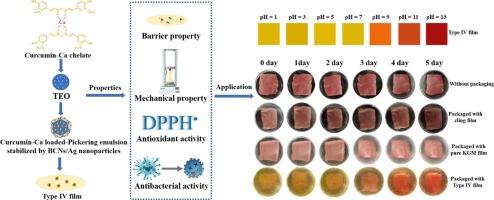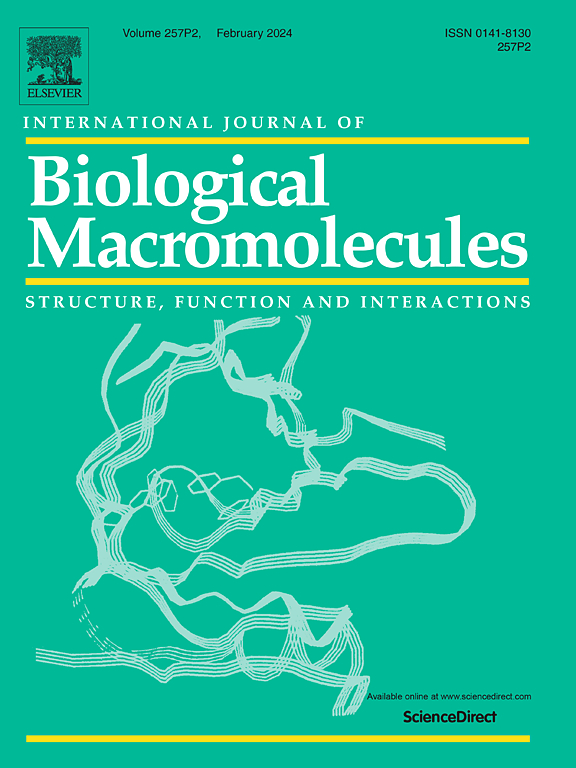Development of konjac glucomannan-based active-intelligent emulsion films loaded with different curcumin-metal chelates: Stability, antioxidant, fresh-keeping and freshness detection properties
IF 7.7
1区 化学
Q1 BIOCHEMISTRY & MOLECULAR BIOLOGY
International Journal of Biological Macromolecules
Pub Date : 2024-11-02
DOI:10.1016/j.ijbiomac.2024.137231
引用次数: 0
Abstract
The aim of this study was to develop konjac glucomannan (KGM)-based active-intelligent emulsion films loaded with different curcumin-metal chelates, where six types of films were prepared and their corresponding properties were investigated. The FTIR and XRD results showed that curcumin chelated with metal ions successfully. Moreover, curcumin-Ca chelate had the best thermal stability and antioxidant activity with the DPPH and ABTS radical-scavenging activity values of 38.28 % and 22.79 %, respectively. Furthermore, the results of microstructure and contact angle showed that chelation with metal ions improved the interfacial interactions between curcumin-metal chelates and film matrix. Interestingly, KGM-based active-intelligent emulsion films loaded with curcumin-Ca chelate (Type IV film) displayed the best thermal stability with the highest temperature of maximum weight loss at 380 °C, the best mechanical property, the highest total phenol content (17.31 mg gallic acid/g film), as well as the best antioxidant activity with DPPH and ABTS radical-scavenging activity values of 69.24 % and 58.66 %, respectively, and the best antibacterial activity. Consequently, Type IV film was used for the fresh-keeping and freshness detection of pork. The results showed that the pork packaged with Type IV film displayed excellent fresh-keeping properties, including reducing the increase rate of volatile basic nitrogen (TVB-N) and pH values and the decrease rate of hardness and elasticity of pork during storage time. Meanwhile, the color of Type IV film gradually changed from yellow to red. Therefore, this study suggested that KGM-based active-intelligent emulsion films have great potential application in the fresh-keeping and freshness detection of fresh meat.

开发负载不同姜黄素金属螯合物的魔芋葡甘聚糖基活性智能乳液薄膜:稳定性、抗氧化性、保鲜性和新鲜度检测性能。
本研究旨在开发以魔芋葡甘露聚糖(KGM)为基础、负载不同姜黄素-金属螯合物的活性智能乳液薄膜,制备了六种类型的薄膜,并研究了它们的相应特性。傅立叶变换红外光谱和 X 射线衍射结果表明,姜黄素成功地与金属离子螯合。此外,姜黄素-钙螯合物具有最佳的热稳定性和抗氧化活性,其 DPPH 和 ABTS 自由基清除活性值分别为 38.28 % 和 22.79 %。此外,微观结构和接触角的研究结果表明,金属离子螯合改善了姜黄素-金属螯合物与薄膜基质之间的界面相互作用。有趣的是,负载姜黄素-钙螯合物的基于 KGM 的活性智能乳液薄膜(IV 型薄膜)显示出最佳的热稳定性(最大失重温度为 380 ℃)、最佳的机械性能、最高的总酚含量(17.31 毫克没食子酸/克薄膜)、最佳的抗氧化活性(DPPH 和 ABTS 自由基清除活性值分别为 69.24 % 和 58.66 %)以及最佳的抗菌活性。因此,IV 型薄膜被用于猪肉的保鲜和新鲜度检测。结果表明,使用 IV 型薄膜包装的猪肉具有良好的保鲜性能,包括降低猪肉在贮藏期间挥发性碱基氮(TVB-N)和 pH 值的升高率以及硬度和弹性的降低率。同时,IV 型薄膜的颜色由黄色逐渐变为红色。因此,这项研究表明,基于 KGM 的活性智能乳液薄膜在鲜肉保鲜和新鲜度检测方面具有巨大的应用潜力。
本文章由计算机程序翻译,如有差异,请以英文原文为准。
求助全文
约1分钟内获得全文
求助全文
来源期刊
CiteScore
13.70
自引率
9.80%
发文量
2728
审稿时长
64 days
期刊介绍:
The International Journal of Biological Macromolecules is a well-established international journal dedicated to research on the chemical and biological aspects of natural macromolecules. Focusing on proteins, macromolecular carbohydrates, glycoproteins, proteoglycans, lignins, biological poly-acids, and nucleic acids, the journal presents the latest findings in molecular structure, properties, biological activities, interactions, modifications, and functional properties. Papers must offer new and novel insights, encompassing related model systems, structural conformational studies, theoretical developments, and analytical techniques. Each paper is required to primarily focus on at least one named biological macromolecule, reflected in the title, abstract, and text.
文献相关原料
公司名称
产品信息
上海源叶
Thyme essential oil (TEO)

 求助内容:
求助内容: 应助结果提醒方式:
应助结果提醒方式:


